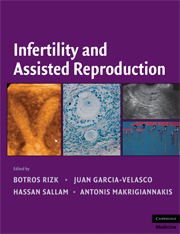14 results
Chapter 19 - Folliculogenesis and Implantation Failure
- from Section 3 - Difficulties and Complications of Ovarian Stimulation and Implantation
-
-
- Book:
- Ovarian Stimulation
- Published online:
- 14 April 2022
- Print publication:
- 05 May 2022, pp 182-188
-
- Chapter
- Export citation
Chapter 49 - Hysterectomy for Benign Conditions
- from Section 10 - Operative Gynaecology
-
-
- Book:
- The EBCOG Postgraduate Textbook of Obstetrics & Gynaecology
- Published online:
- 24 November 2021
- Print publication:
- 02 December 2021, pp 432-436
-
- Chapter
- Export citation
Frontmatter
-
- Book:
- Infertility and Assisted Reproduction
- Published online:
- 04 August 2010
- Print publication:
- 15 September 2008, pp i-vi
-
- Chapter
- Export citation
Contents
-
- Book:
- Infertility and Assisted Reproduction
- Published online:
- 04 August 2010
- Print publication:
- 15 September 2008, pp vii-x
-
- Chapter
- Export citation
PART III - ASSISTED REPRODUCTION
-
- Book:
- Infertility and Assisted Reproduction
- Published online:
- 04 August 2010
- Print publication:
- 15 September 2008, pp 347-348
-
- Chapter
- Export citation
1 - Folliculogenesis: From Preantral Follicles to Corpus Luteum Regression
- from PART I - PHYSIOLOGY OF REPRODUCTION
-
-
- Book:
- Infertility and Assisted Reproduction
- Published online:
- 04 August 2010
- Print publication:
- 15 September 2008, pp 3-9
-
- Chapter
- Export citation

Infertility and Assisted Reproduction
-
- Published online:
- 04 August 2010
- Print publication:
- 15 September 2008
Plate section
-
- Book:
- Infertility and Assisted Reproduction
- Published online:
- 04 August 2010
- Print publication:
- 15 September 2008, pp -
-
- Chapter
- Export citation
Index
-
- Book:
- Infertility and Assisted Reproduction
- Published online:
- 04 August 2010
- Print publication:
- 15 September 2008, pp 759-783
-
- Chapter
- Export citation
PART IV - ETHICAL DILEMMAS IN FERTILITY AND ASSISTED REPRODUCTION
-
- Book:
- Infertility and Assisted Reproduction
- Published online:
- 04 August 2010
- Print publication:
- 15 September 2008, pp 693-694
-
- Chapter
- Export citation
Introduction
-
-
- Book:
- Infertility and Assisted Reproduction
- Published online:
- 04 August 2010
- Print publication:
- 15 September 2008, pp xxiii-xxiv
-
- Chapter
- Export citation
Contributors
-
- Book:
- Infertility and Assisted Reproduction
- Published online:
- 04 August 2010
- Print publication:
- 15 September 2008, pp xi-xviii
-
- Chapter
- Export citation
PART II - INFERTILITY EVALUATION AND TREATMENT
-
- Book:
- Infertility and Assisted Reproduction
- Published online:
- 04 August 2010
- Print publication:
- 15 September 2008, pp 53-54
-
- Chapter
- Export citation
PART I - PHYSIOLOGY OF REPRODUCTION
-
- Book:
- Infertility and Assisted Reproduction
- Published online:
- 04 August 2010
- Print publication:
- 15 September 2008, pp 1-2
-
- Chapter
- Export citation



